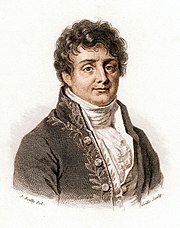تبدیل فوریه

در ریاضیات، تبدیل فوریه (به انگلیسی: Fourier transform، /ˈfʊrieɪ, -iər/) یا (FT) یک تبدیل ریاضیاتی است که توابعی را که بر حسب زمان یا فضا هستند، به توابعی بر حسب فرکانس زمانی یا فضایی تجزیه میکند، مانند بیان یک آکورد موسیقی بر حسب حجمها و فرکانسهای نتهای تشکیل دهنده آن. اصطلاح تبدیل فوریه هم به نمایش دامنه فرکانس و هم به عملیات ریاضی مربوط به آن که نمایش دامنه فرکانس را به تابعی از مکان یا زمان مرتبط میکند گفته میشود.
تبدیل فوریه یک تابع از زمان، یک تابع مقدار مختلط از فرکانس است، که اندازه آن (قدر مطلق)، فرکانس موجود در تابع اصلی را نشان میدهد، و آرگومان آن اختلاف فاز سینوسی پایه در آن فرکانس است. تبدیل فوریه فقط محدود به توابع زمان نیست، اما به دامنه عملکرد اصلی، معمولاً دامنه زمان گفته میشود. معکوس تبدیل فوریه نیز وجود دارد که به صورت ریاضی تابع اصلی را از نمایش دامنه فرکانسی آن تولید میکند، که توسط قضیه عکس فوریه اثبات شدهاست.
عملیاتهای خطی انجام شده در یک دامنه (زمان یا فرکانس) در دامنههای دیگر دارای عملیاتهای متناظر هستند، که گاهی انجام آنها آسانتر است. عملیات مشتقگیری در دامنه زمان معادل با ضرب در فرکانس است، در نتیجه تجزیه و تحلیل برخی معادلات دیفرانسیلی در دامنه فرکانس راحت تر است. همچنین، کانولوشن در دامنه زمان معادل با ضرب معمولی در دامنه فرکانس است (به قضیه کانولوشن مراجعه کنید). پس از انجام عملیات مورد نظر، میتوان نتیجه را به حوزه زمان برگرداند. آنالیز هارمونیک یک مطالعه سیستماتیک از رابطه بین دامنههای فرکانس و زمان است، از جمله انواع توابع یا عملیاتی که در یکی یا دیگری «سادهتر» هستند و با بسیاری از زمینههای ریاضیات مدرن ارتباط عمیقی دارد.[۱]
| تبدیل فوریه |
|---|

|
| تبدیل فوریه پیوسته |
| سری فوریه |
| تبدیل فوریه گسسته |
| تبدیل فوریه گسستهزمان |
تعریف
[ویرایش]تبدیل فوریه، نامیده شده به اسم ریاضیدانِ فرانسوی ژوزف فوریه، یک تبدیل انتگرالی است که هر تابع را به یک تابع دیگر منعکس میکند. در این صورت، به تبدیل فوریهٔ تابع میگویند. حالت خاص تبدیل فوریه، سری فوریه نام دارد و آن زمانی کاربرد دارد که تابع متناوب باشد، یعنی: . چنانچه تابع متناوب نباشد یا به عبارتی، تناوب آن برابر بینهایت باشد ()، از سری فوریه عبارت زیر به دست میآید:
تبدیل فوریه و به همراه آن آنالیز فوریه، در مباحث مختلف فیزیک، از جمله الکترونیک و الکترومغناطیس (به خصوص در مخابرات)، آکوستیک، فیزیک امواج و غیره کاربرد فراوان دارد.
کاربرد
[ویرایش]
تبدیلات فوریه در طیف وسیعی از مسائل حوزههای مهندسی و فناوری و همچنین در مخابرات و محاسبات تصویری کاربردهای وسیعی دارند. بهطور مثال در امآرآی در فیزیک پزشکی برای ایجاد تصویر نهایی اطلاعات امواج ساطع شده از هستههای هیدروژن از حوزهٔ فرکانسی (frequency domain) به حوزهٔ فضایی (spatial domain) تبدیل فوریه میشوند.
همچنین در علم دینامیک سازهها و ارتعاشات مکانیکی برای تعیین پاسخ سازه در برابر تحریکات غیر هارمونیک از تبدیلات فوریه برای تبدیل این تحریکات به اجزای هارمونیک استفاده میشود. پس از آن میتوان اقدام به حل معادله دیفرانسیل حرکت سازه نمود.
یکی دیگر از کاربردهای آن در تجزیه و تحلیل مدارات مخابراتی و مدارات قدرت است که برای بدست آوردن هارمونیکهای پدیدآورنده یک شکل موج استفاده میشود.[۲][۳][۴]
تبدیل سریع فوریه
[ویرایش]تبدیل سریع فوریه (Fast Fourier transform - FFT) نام الگوریتمیست برای انجام تبدیلات مستقیم و معکوس گسستهٔ فوریه به صورتی سریع و بسیار کارآمد. تعداد زیادی الگوریتمهای تبدیل فوریه سریع مجزا وجود دارد که شامل محدوده عظیمی از ریاضیات میشوند: از محاسبات ساده به وسیله اعداد مختلط تا نظریه اعداد.
جدول تبدیلهای فوریه مهم
[ویرایش]جداول زیر برخی از تبدیلهای فوریه نوع بسته را نشان میدهد. برای توابع g(x) , f (x) و h(x) تبدیل فوریه آنها را به ترتیب با ĝ، f̂ و ĥ نشان داده میشوند. فقط سه نمایش رایج در جدول گنجانده شدهاست. توجه داشته باشید که ورودی ۱۰۵ رابطه ای بین تبدیل فوریه یک تابع و تابع اصلی ایجاد میکند، که میتواند به عنوان رابطه تبدیل فوریه و عکس آن باشد.
روابط تابعی، یک بعدی
[ویرایش]تبدیلهای فوریه زیر را میتوان در (Erdélyi 1954) یا (Kammler 2000، ضمیمه). یافت.
| تابع | تبدیل فوریه
فرکانس واحد، عادی |
تبدیل فوریه
فرکانس واحد، زاویه ای |
تبدیل فوریه
فرکانس زاویه ای غیر واحد |
ملاحظات | |
|---|---|---|---|---|---|
| تعریف | |||||
| ۱۰۱ | خطی بودن | ||||
| ۱۰۲ | تغییر در دامنه زمان | ||||
| ۱۰۳ | تغییر در دامنه فرکانسی، جفت ۱۰۱ | ||||
| ۱۰۴ | تغییر مقیاس در دامنهٔ زمان. اگر |a| زیاد باشد، آنگاه f (ax) به سمت صفر متمرکز میشود و پهنتر و صافتر میشود. | ||||
| ۱۰۵ | دوگان خود تبدیل فوریه. در اینجا لازم است f̂ با همان روش ستون تبدیل فوریه محاسبه شود. نتیجهٔ جابه جایی متغیرهای آزاد x و ξ یا ω یا ν. | ||||
| ۱۰۶ | |||||
| ۱۰۷ | این دوگان ۱۰۶ است | ||||
| ۱۰۸ | علامت f ∗ g کانولوشن توابع f و g را نشان میدهد — به این قاعده قضیهٔ کانولوشن میگویند | ||||
| ۱۰۹ | این دوگان ۱۰۸ است. | ||||
| ۱۱۰ | For f (x) purely real | Hermitian symmetry. z indicates the complex conjugate. | |||
| ۱۱۱ | For f (x) purely real and even | f̂ (ξ), f̂ (ω) and f̂ (ν) are purely real even functions. | |||
| ۱۱۲ | For f (x) purely real and odd | f̂ (ξ), f̂ (ω) and f̂ (ν) are purely imaginary odd functions. | |||
| ۱۱۳ | برای f (x) موهومی خالص | z indicates the complex conjugate. | |||
| ۱۱۴ | Complex conjugation, generalization of 110 and 113 | ||||
| ۱۱۵ | This follows from rules 101 and 103 using Euler's formula:
| ||||
| ۱۱۶ | This follows from 101 and 103 using Euler's formula:
| ||||
توابع انتگرالگیری شونده مربعی، یک بعدی
[ویرایش]تبدیلهای فوریه زیر را میتوان در Campbell & Foster (1948)، Erdélyi (1954)، یا Kammler (2000، قسمت ضمیمه) یافت.
| تابع | تبدیل فوریه
فرکانس واحد، عادی |
تبدیل فوریه
فرکانس واحد، زاویه ای |
تبدیل فوریه
فرکانس زاویه ای غیر واحد |
ملاحظات | |
|---|---|---|---|---|---|
| ۲۰۱ | The rectangular pulse and the normalized sinc function, here defined as sinc(x) = sin(πx)/πx | ||||
| ۲۰۲ | Dual of rule 201. The rectangular function is an ideal low-pass filter, and the sinc function is the non-causal impulse response of such a filter. The sinc function is defined here as sinc(x) = sin(πx)/πx | ||||
| ۲۰۳ | The function tri(x) is the triangular function | ||||
| ۲۰۴ | Dual of rule 203. | ||||
| ۲۰۵ | The function u(x) is the Heaviside unit step function and a> 0. | ||||
| ۲۰۶ | This shows that, for the unitary Fourier transforms, the Gaussian function e−αx2 is its own Fourier transform for some choice of α. For this to be integrable we must have Re(α)> ۰. | ||||
| ۲۰۷ | This is known as the complex quadratic-phase sinusoid, or the "chirp" function.[۵] | ||||
| ۲۰۸ | For Re(a)> 0. That is, the Fourier transform of a two-sided decaying exponential function is a Lorentzian function. | ||||
| ۲۰۹ | Hyperbolic secant is its own Fourier transform | ||||
| ۲۱۰ | Hn is the nth-order Hermite polynomial. If a = 1 then the Gauss–Hermite functions are eigenfunctions of the Fourier transform operator. For a derivation, see Hermite polynomial. The formula reduces to 206 for n = ۰. |
توزیعها، یک بعدی
[ویرایش]| تابع | تبدیل فوریه
فرکانس واحد، عادی |
تبدیل فوریه
فرکانس واحد، زاویه ای |
تبدیل فوریه
فرکانس زاویه ای غیر واحد |
ملاحظات | |
|---|---|---|---|---|---|
| ۳۰۱ | The distribution δ(ξ) denotes the Dirac delta function. | ||||
| ۳۰۲ | Dual of rule 301. | ||||
| ۳۰۳ | This follows from 103 and 301. | ||||
| ۳۰۴ | This follows from rules 101 and 303 using Euler's formula:
| ||||
| ۳۰۵ | This follows from 101 and 303 using
| ||||
| ۳۰۶ | This follows from 101 and 207 using
| ||||
| ۳۰۷ | This follows from 101 and 207 using
| ||||
| ۳۰۸ | Here, n is a natural number and δ(n)(ξ) is the nth distribution derivative of the Dirac delta function. This rule follows from rules 107 and 301. Combining this rule with 101, we can transform all polynomials. | ||||
| Dual of rule 308. δ(n)(ξ) is the nth distribution derivative of the Dirac delta function. This rule follows from 106 and 302. | |||||
| ۳۰۹ | Here sgn(ξ) is the sign function. Note that 1/x is not a distribution. It is necessary to use the Cauchy principal value when testing against Schwartz functions. This rule is useful in studying the Hilbert transform. | ||||
| ۳۱۰ | 1/xn is the homogeneous distribution defined by the distributional derivative
| ||||
| ۳۱۱ | This formula is valid for 0> α> −1. For α> 0 some singular terms arise at the origin that can be found by differentiating 318. If Re α> −1, then |x|α is a locally integrable function, and so a tempered distribution. The function α ↦ |x|α is a holomorphic function from the right half-plane to the space of tempered distributions. It admits a unique meromorphic extension to a tempered distribution, also denoted |x|α for α ≠ −۲, −4,... (See homogeneous distribution.) | ||||
| Special case of 311. | |||||
| ۳۱۲ | The dual of rule 309. This time the Fourier transforms need to be considered as a Cauchy principal value. | ||||
| ۳۱۳ | The function u(x) is the Heaviside unit step function; this follows from rules 101, 301, and 312. | ||||
| ۳۱۴ | This function is known as the Dirac comb function. This result can be derived from 302 and 102, together with the fact that
as distributions. | ||||
| ۳۱۵ | The function J0(x) is the zeroth order Bessel function of first kind. | ||||
| ۳۱۶ | This is a generalization of 315. The function Jn(x) is the nth order Bessel function of first kind. The function Tn(x) is the Chebyshev polynomial of the first kind. | ||||
| ۳۱۷ | γ is the Euler–Mascheroni constant. | ||||
| ۳۱۸ | This formula is valid for 1> α> 0. Use differentiation to derive formula for higher exponents. u is the Heaviside function. |
توابع دو بعدی
[ویرایش]| تابع | تبدیل فوریه
فرکانس واحد، عادی |
تبدیل فوریه
فرکانس واحد، زاویه ای |
تبدیل فوریه
فرکانس زاویه ای غیر واحد |
ملاحظات | |
|---|---|---|---|---|---|
| ۴۰۰ | The variables ξx, ξy, ωx, ωy, νx, νy are real numbers. The integrals are taken over the entire plane. | ||||
| ۴۰۱ | Both functions are Gaussians, which may not have unit volume. | ||||
| ۴۰۲ | The function is defined by circ(r) = 1 for ۰ ≤ r ≤ 1, and is 0 otherwise. The result is the amplitude distribution of the Airy disk, and is expressed using J1 (the order-1 Bessel function of the first kind).[۶] | ||||
| ۴۰۳ | This is the Hankel transform of r−1, a 2-D Fourier "self-transform".[۵] | ||||
| ۴۰۴ |
فرمولهایی برای توابع عمومی n بعدی
[ویرایش]| تابع | تبدیل فوریه
فرکانس واحد، عادی |
تبدیل فوریه
فرکانس واحد، زاویه ای |
تبدیل فوریه
فرکانس زاویه ای غیر واحد |
ملاحظات | |
|---|---|---|---|---|---|
| ۵۰۰ | |||||
| ۵۰۱ | The function χ[0, 1] is the indicator function of the interval [0, 1]. The function Γ(x) is the gamma function. The function Jn/2 + δ is a Bessel function of the first kind, with order n/2 + δ. Taking n = 2 and δ = 0 produces 402.[۷] | ||||
| ۵۰۲ | See Riesz potential where the constant is given by
The formula also holds for all α ≠ −n, −n − 1, ... by analytic continuation, but then the function and its Fourier transforms need to be understood as suitably regularized tempered distributions. See homogeneous distribution.[remark ۱] | ||||
| ۵۰۳ | This is the formula for a multivariate normal distribution normalized to 1 with a mean of 0. Bold variables are vectors or matrices. Following the notation of the aforementioned page, Σ = σ σT and Σ−1 = σ−T σ−1 | ||||
| ۵۰۴ | Here[۸] Re(α)> ۰ |
جستارهای وابسته
[ویرایش]یادداشتها
[ویرایش]- ↑ In (Gelfand و Shilov 1964، ص. 363), with the non-unitary conventions of this table, the transform of is given to be from which this follows, with .
پانویس
[ویرایش]- ↑ (Dym و McKean 1985)
- ↑ (Khare، Butola و Rajora 2023، صص. 13–14)
- ↑ (Kaiser 1994، ص. 29)
- ↑ (Rahman 2011، ص. 11)
- ↑ ۵٫۰ ۵٫۱ Jr, Roger L. Easton (2010). Fourier Methods in Imaging (به انگلیسی). John Wiley & Sons. ISBN 978-0-470-68983-7. Retrieved 26 May 2020.
- ↑ (Stein و Weiss 1971، Thm. IV.3.3).
- ↑ (Stein و Weiss 1971، Thm. 4.15).
- ↑ (Stein و Weiss 1971، ص. 6).
منابع
[ویرایش]- Howe, Roger (1980), "On the role of the Heisenberg group in harmonic analysis", Bulletin of the American Mathematical Society, 3 (2): 821–844, doi:10.1090/S0273-0979-1980-14825-9, MR 0578375.
- Stein, Elias; Weiss, Guido (1971), Introduction to Fourier Analysis on Euclidean Spaces, Princeton, N.J.: Princeton University Press, ISBN 978-0-691-08078-9.



























































































































































































































![{\displaystyle \chi _{[0,1]}(|\mathbf {x} |)\left(1-|\mathbf {x} |^{2}\right)^{\delta }}](https://wikimedia.org/api/rest_v1/media/math/render/svg/c1f3e6c1f52f0ee9366c40ee6f67c65f11dbd03a)



















